Build-a-Tree: Evolution Puzzle Game
by Michael Horn (July 3, 2015)
Over the past few years I've been working with Florian Block, Chia Shen, and the Life on Earth team to create an evolution puzzle game called Build-a-Tree (BAT) for natural history museums and other informal learning spaces. This has been a challenging project from the beginning. Evolution is a fascinating topic, but it's still hard to get people to engage in difficult science thinking in free-choice environments. Our challenge was to strike the right balance between fun and learning, while using the game as a starting point for deeper conversations.
Build-a-Tree debuted as part of the Tree of Life exhibit at the California Academy of Sciences in October 2012. Florian and Chia followed that up with a web-based version of the game that was released as part of a PBS NOVA Lab on evolution. Eventually we'd like to make BAT available as a tool that anyone could use to illustrate evolution concepts. The idea is to make it easy to embed custom BAT levels in blogs, web pages, or mobile apps. To give a sense for what this would be like, you can try the game as part of this post. Just drag the species circles in the green window together to start building a tree...
Game Levels
Level Cleared!

Credits
Build-a-Tree was created by the
Life on Earth project and
TIDAL Lab.
Game design by Michael Horn, Florian Block, and the Life on Earth team.
Programming by Florian Block and Michael Horn.
| Chia Shen (PI) | Harvard University |
| Judy Diamond (co-PI) | University of Nebraska State Museum |
| E. Margaret Evans (co-PI) | University of Michigan |
| Michael S. Horn (co-PI) | Northwestern University |
| Florian Block | Harvard University |
| Brenda C. Phillips | Boston University |
| Science Advisors | James Hanken, Gonzola Giribet, Jonathan Losos, Andrew Berry, Hopi-Hoekstra, David Mindell, Sebastian Velez, and Mark Westneat. |
|
Follow us on Twitter @DeepTreeExhibit |
Join us on Facebook facebook.com/DeepTreeExhibit |
This app is based upon work supported by the National Science Foundation under grant DRL-1010889. Any opinions, findings, and conclusions or recommendations expressed in this material are those of the author(s) and do not necessarily reflect the views of the National Science Foundation (NSF).
In this post I'm going to talk about how our design changed over time as we struggled to find the right balance of fun, playability, and value as a learning experience.
Learning Goals
As we were putting BAT together, we had a few big-picture learning goals in mind. The first is that all life on earth is related. In other words, if you could travel far enough back in time, you could find a common genetic ancestor for any two organisms on the planet, no matter how different they might seem. So, just like you and your cousin share an ancestor in common (a grandparent), you and the banana you ate for breakfast also share a distant, distant ancestor. The difference is that unlike your grandparent, this ancestor was a primordial Eukaryotic organism that carried genetic information that is still shared by all plants and animals to this day.
The second big idea is that there are key evolutionary landmarks that define major groups of life. These landmarks are shared genetic traits that emerged from evolutionary processes (like natural selection, genetic drift, and mutation), and allowed organisms to take advantage of new ecological niches. One of my favorite examples is the amniotic egg sac that made it possible for the common ancestors of modern-day birds, mammals, and reptiles to lay eggs away from water and colonize newly accessible inland habitats. Amphibians don't have this trait, which means that they have to return to the water to lay eggs and reproduce.
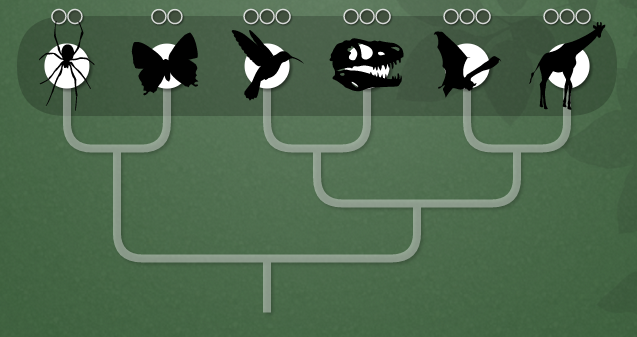 The last big idea relates to something called tree-thinking skills.
One of the most important representations of modern biology is called a cladogram or a phylogenetic tree.
These diagrams depict hypothesized relationships and traits of organisms, genes, or even proteins.
Baum, Smith, and Donovan published an influential
paper in the journal, Science,
arguing that everyone should learn tree-thinking skills as a matter of basic science education.
These skills include to being able to read and understand trees without misinterpreting their meaning.
Common mistakes include assuming that the left-to-right ordering of a tree is important or that the organisms on the
far right side are the most "evolved".
For example, a misunderstanding of the tree shown here is that giraffes are the most complex or evolved species
(which is not true), and that butterflies and birds are more closely related than birds and giraffes (also not true).
The last big idea relates to something called tree-thinking skills.
One of the most important representations of modern biology is called a cladogram or a phylogenetic tree.
These diagrams depict hypothesized relationships and traits of organisms, genes, or even proteins.
Baum, Smith, and Donovan published an influential
paper in the journal, Science,
arguing that everyone should learn tree-thinking skills as a matter of basic science education.
These skills include to being able to read and understand trees without misinterpreting their meaning.
Common mistakes include assuming that the left-to-right ordering of a tree is important or that the organisms on the
far right side are the most "evolved".
For example, a misunderstanding of the tree shown here is that giraffes are the most complex or evolved species
(which is not true), and that butterflies and birds are more closely related than birds and giraffes (also not true).
We had lots of other learning goals that were more factual in nature. For example, it would be nice if people learned that lizards and humans are more closely related than lizards and frogs. But this kind of factual knowledge was less important than big-picture concepts that support a deeper understanding of evolution.
Design Principles
To get at these learning objectives, our design was guided by a number of design principles mostly taken from research on learning, games, and museums. One of the most important concepts is called intrinsic integration. This concept was originally proposed by Yasmin Kafai and then elaborated on by Habgood & Ainsorth in an influential paper in the Journal of the Learning Sciences. Intrinsic integration is meant to contrast with the edutainment movement of the 1990s in which game-like elements and incentives were used to motivate kids to do educational activities that they would otherwise be less interested in. In other words, it's not about making learning fun as much as it's about making it more palatable. The difference with intrinsic integration is that you're trying to tightly integrate game play with the target learning objectives. This has some important implications.
First and most important, games should be fun. This doesn't mean that they have to be easy, but they shouldn't feel like drudge work. My friend Nathan Holbert thinks a lot about the fun factor in his dissertation research with Uri Wilensky. This also means that the fun parts of the game should be the same as the learning parts, which is what the word integration refers to. You want the most exciting and interesting bits of the game to be where players are engaging with your learning objectives. Lastly, the core mechanics of the game should involve the manipulation of external representations of the learning content. This last part is jargony, but for us it just means that you play the game by building phylogenetic trees. And, importantly, these trees are similar to those used by real scientists use to describe evolutionary relationships.
There was one other really important goal for us. Because we had initially designed BAT as a museum exhibit, the first 30 seconds of visitors' experience with the game is crucial. Sue Allen, who was writing about exhibit design at the Exploratorium in San Francisco, called this principle immediate apprehendability. The same idea has also been referred to as early assured success by the Science Museum of Minnesota. I just call this the 30-second rule. If visitors can't figure out what's going on with your exhibit in the first 30 seconds, they're going to walk away and find something else to do. This doesn't mean that they have to understand everything about the exhibit from top to bottom, but they at least need to get how they're supposed to play the game and get some positive reinforcement around their actions. Scott Snibbe and Hayes Raffle have a great paper from the CHI 2009 conference called Social Immersive Media that digs into some of they ways you can go about doing this.
First Version
I started work on the design and programming for the first version of BAT in late 2010. For this first pass, I was preoccupied with playfulness and simplicity. To build trees, all you had to do was drag species tokens together on the touch screen. The order in which tokens were assembled would determine how the tree appeared. So, for example, if you dragged bats and birds together first, followed by humans, you would get the tree shown below. But, if you dragged humans and bats together first, you would get a different tree with humans and bats sharing a more recent common ancestor. If the tree you created was "incorrect", the tree would appear greyed out. But if it was correct, it would appear white, and you would earn stars. With this design, the tree structure just appeared automatically with traits drawn in place.
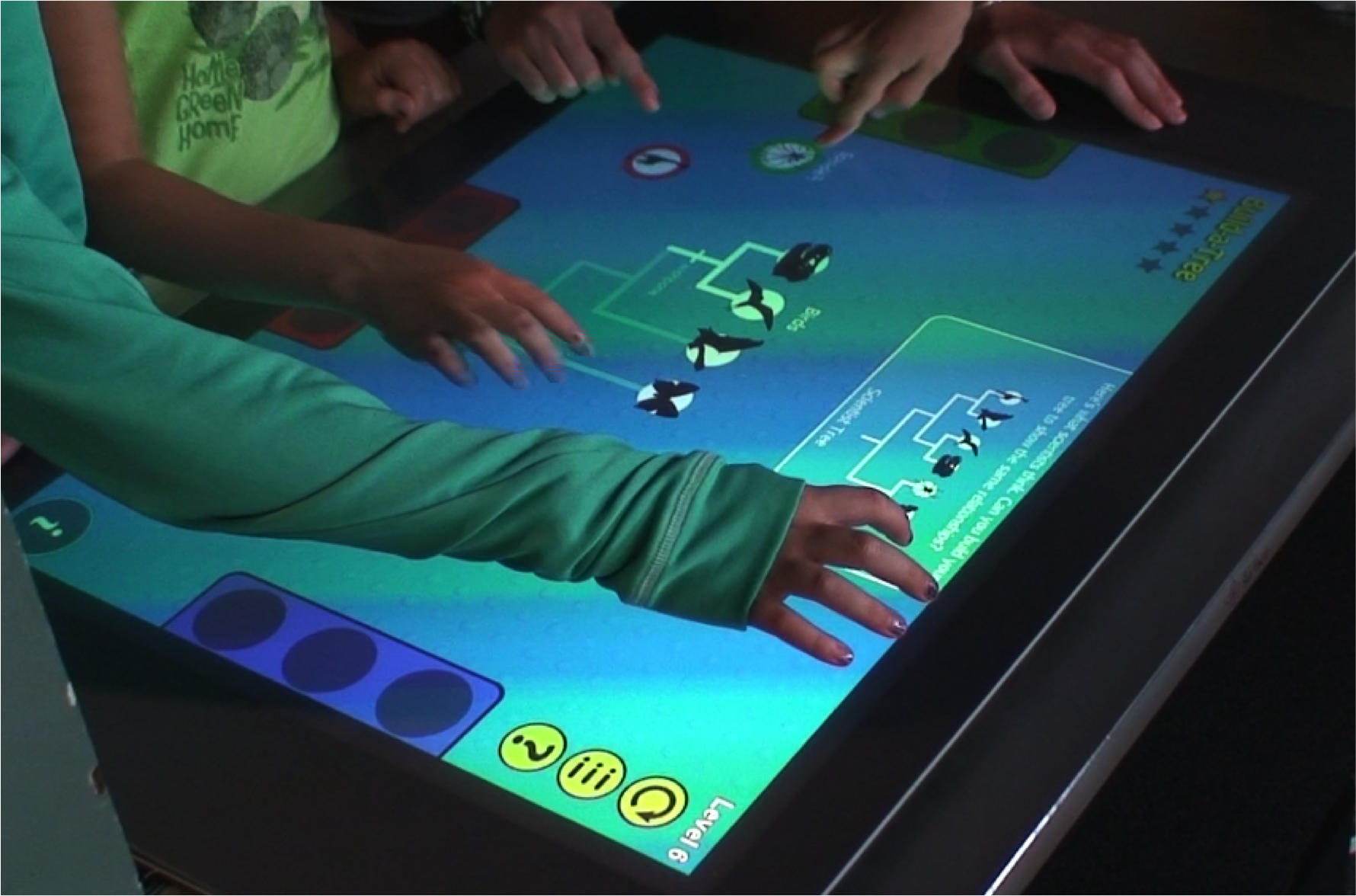
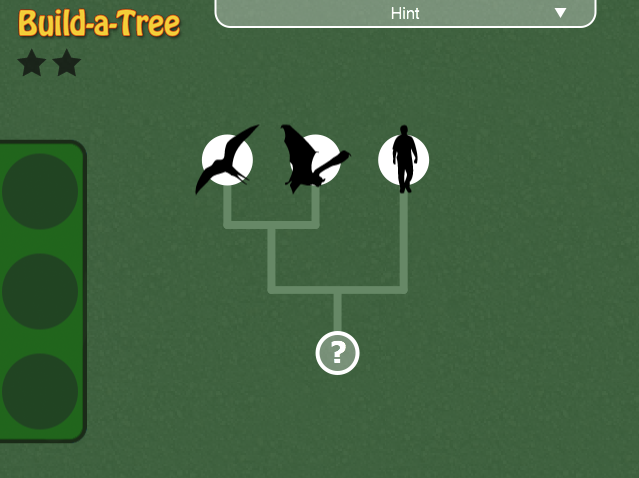
In some ways this first version of BAT seemed successful. Over the summer of 2011, we observed 188 visitors at the Harvard Museum of Natural History. Based on our observations, visitors generally seemed engaged, they were reasonably good at figuring out the game mechanics in a short amount of time, and lots of people stuck around to try to finish all seven levels that we offered. They even talked about evolution, although maybe not in the depth that we were hoping for. Around 70% of the visitors stuck around for at least a minute, and 28% longer than four minutes, which about what you want for an interactive museum exhibit. Shorter than that is an indication that people are struggling to figure out what they're supposed to do or worse that the activity is too shallow. Longer than that, and you risk causing a backup in the flow of visitors or distracting people from all of the other amazing things to see and do at the museum.
The multi-touch tabletop also seemed to provide decent support for collaboration. Visitors worked together and crowded around all sides of the table, collaborating in ways both expected and unexpected. So all of this was pretty good, but there were a few big problems as well: First, because of our emphasis on simplicity, people were only indirectly manipulating the tree structure by dragging species together. This meant that there was a lack of direct control over the placement of the tips in the tree. To try different combinations, you had to drag the tree apart and start over. Second, people had difficulty connecting traits to their corresponding species. Since the idea of shared traits was one of our most important learning objectives, this seemed like a big shortcoming. Lastly, people weren't using the help function for the most part. And, even when they did use it, it didn't really tell you anything useful about the traits.
All of this was clear from watching visitors play at the museum. Even though lots of people were determined to finish the entire game, there was a shift as they advanced to the harder levels. They would start to understand what was going on after the first few levels, but as the levels got harder, they would give up and revert to trying random combinations without much thinking. Some early thrashing like this is probably good, but people weren't able to use what they had learned in early levels to systematically solve the puzzles in the harder levels.
Second Version
Based on these problems, it seemed like it was time for a redesign. We started with a series of design sessions with paper prototypes. Then Florian Block took the best of these ideas and built a new prototype with several new features. First, traits are objects in their own right that players have to drag and place on the tree to solve levels. Players also had much more direct control over the structure of tree itself. Florian introduced splitter tokens that can be dragged onto the tree in order to introduce branching points. Once branching points were defined, it was easy to rearrange the species tokens along the canopy of the tree. So the order in which players placed species tokens on the tree was much less important. Florian also introduced an animated flow from the root of the tree up to the tips. The nice part about this flow was that it showed how traits would spread through branching points to all descendants of a particular clade. This reinforced tree thinking skills and the idea of shared ancestral traits. Finally, a new microscope feature let visitors learn more about the traits themselves and what those traits mean for different species.
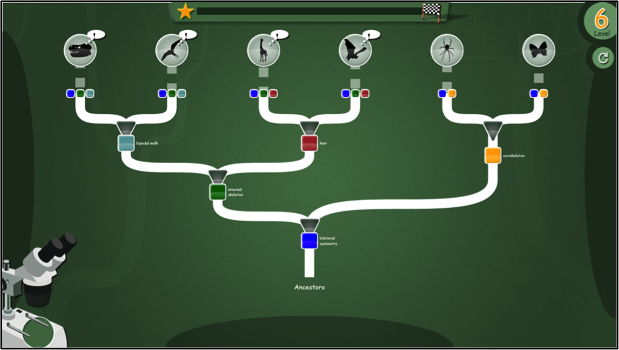
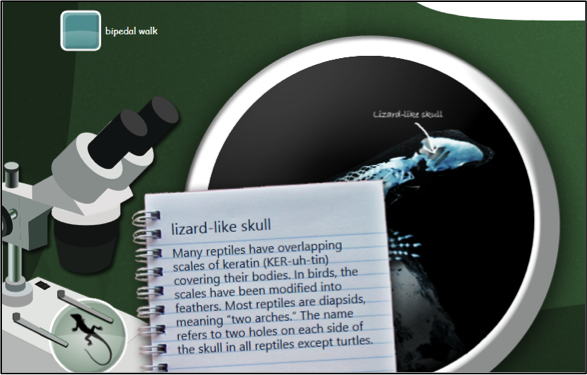
We tested this new version at the Field Museum in Chicago with 40 parent-child pairs. We're still in the process of analyzing the video data from this study, but we saw some important shifts in game play. First, the game was clearly harder; you have to think more, especially in the earlier levels. But, players were also focusing much more on the tree itself and the relationships between traits and organisms. This seemed like a huge improvement that was reflected in the kind of evolution talk that we were hearing from players. The microscope, when it was used, also seemed much more informative and helpful than the help feature in the previous version.
All of this seemed like a positive step forward. Our biggest worry was that we had lost a little of playfulness of the original game and that it was a little too hard for families to figure out what they were supposed to do without explicit scaffolding. And that led to another revision...
Third Version and Beyond?
Our last major iteration tried to combine the best parts of the previous two versions. For the most part this meant removing the splitter tokens and bringing back the features that let people build trees by touching species tokens together. Of course, it's a little more complicated than that because we wanted to make it easier to reorganize the tree structure without having to tear everything apart and start from scratch. This meant that Flo and I spent a lot of time refining the interaction to be intuitive and simple, but flexible as well. So that's where we are. Please send your comments, feedback, and suggestions!
Other stuff to read
- Snibbe, S. and H. Raffle. (2009). Social Immersive Media: Pursuing best practices for multi-user interactive camera/projector exhibits. Proceedings of the ACM Conference on Human Factors in Computing Systems (CHI'09).
- Villanosa, K., Block, F., Horn, M.S., Shen, C. (2014). Build-a-Tree: Parent-child gaming to learn about evolution in museum settings. Games, Learning, and Society (GLS'14).
- Horn, M.S., Leong, Z.A., Block, F., Diamond, J., Evans, E.M., Phillips, B., Shen, C. (2012). Of BATs and APEs: An interactive tabletop game for natural history museums. Proceedings of the ACM Conference on Human Factors in Computing Systems (CHI'12).
- Sue Allen. (2004). Designs for learning: Studying science museum exhibits that do more than entertain. Science Education, 88(S1), S17–S33.
Credits
Lots of people helped make BAT possible. The Life on Earth Team included Chia Shen (Harvard University), Judy Diamond (University of Nebraska State Museum), E. Margaret Evans (University of Michigan), Michael Horn (Northwestern University), Florian Block (Harvard University), and Brenda Phillips (Boston University). Zeina Atrash Leong (Northwestern University) and Krystal Villanosa (Northwestern University) ran the studies at the Field Museum and the Harvard Museum of Natural History with the assistance of Audrey Hosford. Sebastian Velez verified the evolutionary relationships that appear in the game and provided valuable help identifying appropriate biological traits. We thank the Harvard Museum of Natural History and Janis Sacco, and the Field Museum and Matt Matcuk and Jaap Hoogstraten for allowing us to conduct this research in their galleries. Finally, we thank the National Science Foundation for their support of this project (DRL-1010889). Any opinions, findings and conclusions or recommendations expressed in this material are those of the authors and do not necessarily reflect the views of the National Science Foundation.